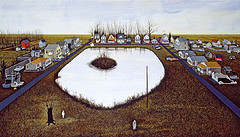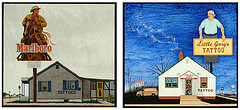
Snow Melt, Snow Farm
The wide sweep Mary Tobias Putman’s rural landscape paintings, mixed with the exactitude of detailed brush strokes, invoke an America where all is right with the world and where the human enterprise is suitably dwarfed by the land.
I am reminded of seascapes, those views from the crows nest, where the great beyond is nothing but waves all the way to the high horizon line. The boat is a fragile but buoyant voyager on the seas of life.
But Putman’s horizon line is straight as an arrow–a mixture of her flattening of the earth plus a suggestion that what we see is only a small part of a very large picture.
The dimensions of these paintings are so wide, they do not reproduce well at the scale of artblog, so under each painting is a link to a larger version on the gallery’s website.

Self-Portrait at 65 shows a rather anonymous-looking Putman, as Everyman, atop a lift, providing a hint of how she develops the views she paints
In the exhibit at Gross McCleaf Gallery, Putman takes the long view by looking at her landscape from high up on a lift. She even provides a self-portrait of herself doing this, imagining herself as she would like herself to be at the age of 65. She began the painting titled “Self Portrait at 65” when she was 60. Now she’s 63.
The humorous modesty or recognition that humans are blips is reflected in the tiny generic figures, some of whom look like roly-poly Weebles, some so tiny that even in the full-size painting, they are barely readable.

Woodland Beach
But the affection behind these paintings is self-evident, affection for the people and their plight, and the affection for the land, sometimes scarred by the wheels across the fields, sometimes interrupted by a deliberately planted screen of trees, a barn, a development that serves as a precursor of coming suburbia.
The land is manipulated with the human touch of agriculture and bits of development. It’s owned land, not wild land, and it’s the land that sustains us and makes our lives have meaning.
The color in these paintings is glorious and suffused with warm ochre stripes of agricultural activity, plus bits of green and red for the vehicles and the buildings and trees.
Though there’s some Grandma Moses here in the flat style and the love of land, Putman’s work is further from the hurly burly of community.

Rough Riders 1985-2005
Even in Putman’s flat portraits of commercial enterprise, which are modest in size, she uses the perspective of time to raise questions about our ideals and aging, as in the diptych Rough Riders, 1985-2005. Here the Marlboro Man has morphed into a guy with a gut, peddling tattoos. These pieces are not as beautiful or passionate, however, as the landscapes, which are considered, wise, and for all their size, unpretentious and intimate.





